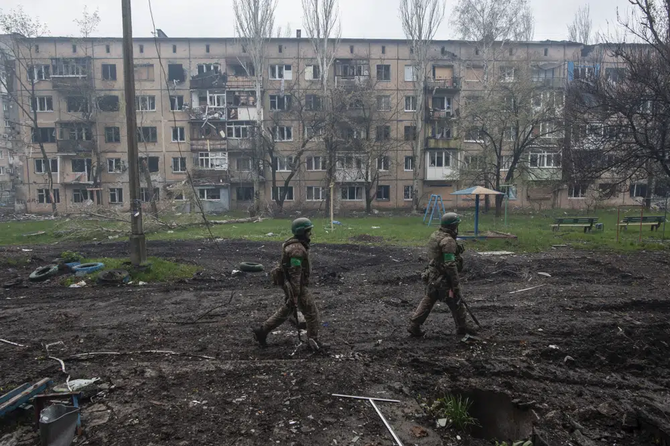Chris Doyle
The backdrop to the annual gathering of G7 leaders last week was extraordinarily poignant. Nowhere signifies the dangers of war better than Hiroshima, the site of the first use of the atomic bomb. Back in August 1945, a US bomb killed tens of thousands of people. The Japanese hosts wanted to remind the world of the horrors of nuclear warfare, not least as we are currently in the throes of the Russia-Ukraine crisis.
Even today, a debate rages as to how many died as a result of the firestorm from “Little Boy.” The estimates range from 70,000 to 140,000. The challenge is not helped by the Japanese not being sure of the population of the city at the time. And should the figure only include those killed during the explosion or should it cover the first week, month or year? Should the figure include those who died due to long-term radiation exposure? Decades later and the question of fatality counts in wars remains a huge debate. Wars are a costly business. Calculating these costs in the 21st century is a challenging, even Herculean, task. But it matters. Decision-makers need to know what the true cost is. Tallying the direct costs of war is considerably less daunting than the indirect costs – the long-term impact on societies through the likes of disease, suicides and the destruction of economies and health systems.
The Costs of War Project at Brown University has just published a detailed study on exactly what have been these indirect costs from the so-called 9/11 wars. It is sobering. It puts the total death toll from the wars in Iraq, Syria, Afghanistan, Pakistan and Yemen at 4.5 million to 4.6 million. It calculates the indirect deaths as being 3.6 million to 3.7 million. The fact that indirect deaths typically outnumber direct deaths in modern warfare shows how significant an issue this is. This is not an exact science. The report even questions whether, in 2023, even after US forces departed, that any death in Afghanistan can be unrelated to the war. Hunger and malnutrition have escalated massively since that ill-fated withdrawal in 2021. Are these deaths any different to those resulting from missile strikes?
Indirect fatality rates are affected by the state of the health of the population pre-conflict. This is why it has been hard to define a precise ratio between direct and indirect death rates. When the war takes place in countries or regions with questionable prewar statistics, it makes the job so much harder, given that statisticians need to know what the typical death rate in a population would be. It is not always easy to determine which fatalities are direct and which are indirect. When a medical center is intentionally bombed and then, due to the absence of medical care, people die, is that a direct consequence? Every Israeli bombardment of Gaza leads to damage to the water and sewage infrastructure, allowing disease to thrive. In wars, many parties have targeted food production facilities, such as bakeries in Syria.
Then consider the unexploded ordnance, the detritus of war left behind, let alone the land mines and cluster munitions deliberately deployed. Take Vietnam. Since 1975, more than 40,000 Vietnamese are estimated to have been killed, with 60,000-plus injured, by unexploded ordnance. There is also a savage economic cost, as these munitions render farmland inaccessible and cut food production. Women and children constitute a large part of the indirect tally, while men are more likely to be killed in combat. Birth-related problems account for some of this. But so many other issues need to be examined, such as the massive mental health impact on a population of war, not least post-traumatic stress disorder.
Massive numbers of deaths due to the indirect effects of war are not new of course. In the Korean War in the 1950s, in which 5 million to 6 million people died, only about 15 percent to 20 percent of that number were direct fatalities of conflict. UNICEF has shown that, in conflict zones, children are 20 times more likely to die from diarrheal disease than war. The combination of malnutrition and disease is a particularly lethal one. Figures will always be contested. The fatality count for the Iraq war of 2003 still arouses great passions. In Syria, the UN stopped doing fatality statistics back in January 2014, when it had estimated a death toll of about 200,000. It then produced a figure of about 350,000 in 2021. At the same time, a major Syrian human rights organization claimed the death doll was more than 600,000. And remember this was all before anyone tried to determine the indirect costs of the war.
These post-9/11 campaigns have displaced 38 million people – the largest number of forced displacements since the Second World War. More than half of the Syrian population has been displaced either as refugees or internally since 2011. War also leads to a massive brain drain. Consider how many of the brightest and best flee for safer climes during times of war. Iraq lost about 18,000 doctors in the five years following the 2003 US invasion. This all brings into question what the eventual human costs of the wars in Ukraine and Sudan will be. The fatality statistics right now are subject to the inevitable war of narratives. It is a reasonable assumption that the number of indirect fatalities in Ukraine will be high, given the levels of bombing, but because it was a well-off nation before the war it may not be as high as, say, in Afghanistan, Somalia or Sudan. This segment of the statistics industry is one we would all like to see retired, with wars consigned to the rubble of history. If only. Some would like to end it prematurely. Who can forget Donald Rumsfeld’s dismissive aside in 2003: “We don’t do body counts on other people.” But the reality is that more of this vital research is required and more light can be shed on the long-lasting impact of wars.
Wisely, the Costs of War report does not attempt to attribute responsibility. This, in some ways, strengthens it, as it does not get into a dangerous blame game that could put leaders off paying attention. It should make chilling reading for those in power – a painful reminder of how easy it is to get into wars, as opposed to exit them, and that the indirect costs have to be considered as well as the direct. If these reports do nothing else, then that lesson alone is worth its weight in gold.







